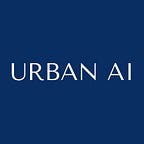CityScope: From Smart Cities to Street Knowledge
By Sarah Popelka, Research Assistant at Urban AI
Ariel Noyman, a researcher at MIT, opened the 4th “Future of Urban AI” lecture with a very poignant graphic: a juxtaposition of the Los Angeles building code legislation from three different years: in 1946, a thin booklet; in 1968, a thin binder- slightly thicker than in 1946; in 2011, a stack of multiple thick volumes. As architecture and urban planning requirements become more complex, designing for urban spaces becomes more and more top-down, slow, and bureaucratic. However, Noyman and his CityScope team at MIT envision a future where evidence-based, data-driven, AI-enabled modeling drives a new urban planning process. In this vision, truly participatory urban planning allows for meaningful co-designing with citizens. Within the past 10 years, they have developed and iterated on the CityScope platform to accomplish four primary competencies: insight, transformation, prediction, and consensus.
In order to provide insight, CityScope functions as an urban observatory. The team overlays layers of data on a 3D model (often constructed from LEGOs). In doing so, they begin to understand dynamics of urban movement and human behavior, based on existing data. During COVID-19, this approach proved particularly useful in identifying which forms of urban congregation bore a greater risk than others. They could overlay information on COVID-19 cases, individual location data, and information about urban activities and amenities to decipher which activities contributed the most to rising case counts. By obtaining this level of granular insight, cities could tailor their confinement strategies and identify key public spaces in which to intervene, in order to limit human-to-human contact and ensure safer public health practices without reverting to a full metropolitan lockdown.
In addition to providing insight, CityScope allows for quantification and experimentation around urban transformation. By “codifying the building code,” the City Scope team were able to turn complex building regulations into computational units of analysis, against which they could benchmark proposed urban designs. Through CityScope, they are able to test the coherence of designs with current building laws, as well as estimate the impacts of the new developments on a number of key performance indicators (e.g. density, diversity, and proximity). This proved useful in Hamburg, Germany in 2018, when the city requested assistance evaluating proposals for an urban redevelopment related to its bid to host the 2024 Olympic games. By utilizing CityScope, the team was able to evaluate proposals in a more data-driven way.
The prediction capabilities of CityScope allow cities to test urban designs and evaluate their utility. To serve this purpose, CityScope employs agent-based modeling to simulate human interactions with and derive use patterns for proposed designs. With traditional urban design practices, prototyping often cannot occur until the proposed development is built. However with CityScope, the team can assess the potential impacts of the designs in question and essentially prototype the urban interventions prior to implementation. The CityScope prediction components were used in high profile urban redevelopment projects, including optimizing certain aspects of transportation planning in Hamburg (by modeling how new transport hubs affect the ways that agents move about the city), and estimating how the Champs-Elysee revitalization plans in Paris, France would affect the manner in which people use the space.
In Noyman’s eyes, however, the real power of CityScope lies in the platform’s consensus-building capabilities. By presenting users with a tangible, intuitive interface composed of familiar materials (like LEGOs), CityScope invites citizens with little to no technical or design experience to interact with proposed projects and co-produce viable solutions. The very medium of CityScope allows urban planning conversations to switch from top-down, technical, and design-focused to bottom-up, accessible, and action-oriented. In the FindingPlaces project, which was commissioned by Hamburg, CityScope was able to engage the public to select 161 viable sites for integrated refugee housing within the city. The prospect of housing refugees in the city might have previously faced strong NIMBY-ism but was instead met with a “yes we can” attitude, mediated by CityScope.
Looking to the future, Noyman envisions the AI components of CityScope as augmenting human capabilities, rather than replacing human capabilities. To improve the adoption and quality of CityScope results, he recommends clearly communicating the models used to citizen participants (so as to avoid pushback due to a lack of understanding how the models work), maintaining long term partnerships with cities (through the creation of a CityLab, which ensures that the city can make the most of the setup overhead associated with implementing CityScope in a new city and to allows the platform and objectives to grow with the needs of the city), and encouraging participating cities to provide robust and easy-to-connect-to data pipelines. These shifts would allow for greater portability of the CityScope platform and provide a larger proliferation of truly participatory and citizen-centered urban design.
By Sarah Popelka, Research Assistant at Urban AI
